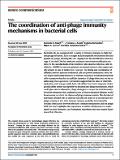Por favor, use este identificador para citar o enlazar a este item:
http://hdl.handle.net/10261/285502COMPARTIR / EXPORTAR:
 SHARE SHARE
 CORE
BASE CORE
BASE
|
|
| Visualizar otros formatos: MARC | Dublin Core | RDF | ORE | MODS | METS | DIDL | DATACITE | |

| Título: | The coordination of anti-phage immunity mechanisms in bacterial cells |
Autor: | Arias, Clemente F. CSIC ORCID; Acosta, Francisco Javier; Bertocchini, Federica CSIC ORCID ; Herrero, Miguel Angel; Fernandez-Arias, Cristina | Palabras clave: | Bacteria CRISPR-Cas systems Phage biology |
Fecha de publicación: | 1-dic-2022 | Editor: | Springer Nature | Citación: | Nature Communications 13: 7412 (2022) | Resumen: | Bacterial cells are equipped with a variety of immune strategies to fight bacteriophage infections. Such strategies include unspecific mechanisms directed against any phage infecting the cell, ranging from the identification and cleavage of the viral DNA by restriction nucleases (restriction-modification systems) to the suicidal death of infected host cells (abortive infection, Abi). In addition, CRISPR-Cas systems generate an immune memory that targets specific phages in case of reinfection. However, the timing and coordination of different antiviral systems in bacterial cells are poorly understood. Here, we use simple mathematical models of immune responses in individual bacterial cells to propose that the intracellular dynamics of phage infections are key to addressing these questions. Our models suggest that the rates of viral DNA replication and cleavage inside host cells define functional categories of phages that differ in their susceptibility to bacterial anti-phage mechanisms, which could give raise to alternative phage strategies to escape bacterial immunity. From this viewpoint, the combined action of diverse bacterial defenses would be necessary to reduce the chances of phage immune evasion. The decision of individual infected cells to undergo suicidal cell death or to incorporate new phage sequences into their immune memory would be determined by dynamic interactions between the host’s immune mechanisms and the phage DNA. Our work highlights the importance of within-cell dynamics to understand bacterial immunity, and formulates hypotheses that may inspire future research in this area. | Descripción: | 11 p.-7 fig. | Versión del editor: | https://doi.org/10.1038/s41467-022-35203-7 | URI: | http://hdl.handle.net/10261/285502 | DOI: | 10.1038/s41467-022-35203-7 | E-ISSN: | 2041-1723 |
| Aparece en las colecciones: | (CIB) Artículos |
Ficheros en este ítem:
| Fichero | Descripción | Tamaño | Formato | |
|---|---|---|---|---|
| Nature Communications_Arias_2022.pdf | Artículo principal | 1,21 MB | Adobe PDF |  Visualizar/Abrir |
CORE Recommender
SCOPUSTM
Citations
4
checked on 02-may-2024
WEB OF SCIENCETM
Citations
2
checked on 28-feb-2024
Page view(s)
35
checked on 10-may-2024
Download(s)
16
checked on 10-may-2024
Google ScholarTM
Check
Altmetric
Altmetric
Este item está licenciado bajo una Licencia Creative Commons

